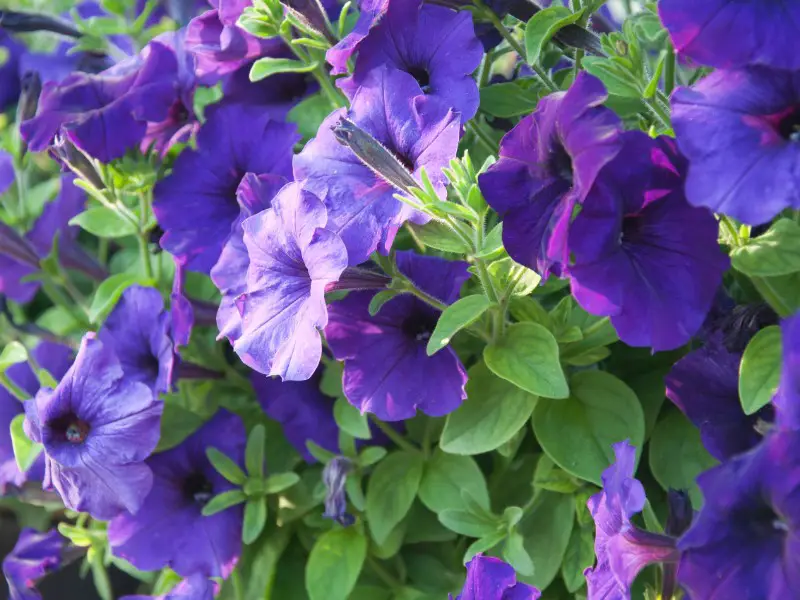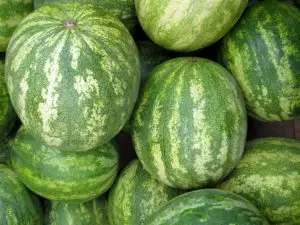Trailing flowers, also known as spillers, are plants with trailing stems that grow down to the ground. These plants are popular among gardeners because the plants offer a vibrant floral display without taking up much floor space. Trailing flowers are also commonly used to accentuate features such as doorways, windows, fences, and walls.
12 Best Trailing Plants for Hanging Baskets & Window Boxes
Trailing flowers like million bells, petunia, and ivy geranium are ideal for hanging baskets and window boxes. These plants work well because they bloom for long periods, have minimal care needs, and are able to grow in limited space. These flowers are colorful and have eyecatching trailing habits.
Million Bells

Million bells have small bell-shaped flowers that come in a range of vibrant shades including pink, yellow, violet, magenta, and white. The flowers grow up to 9 inches tall and bloom prolifically from spring to frost.
These plants are easy to care for because they can tolerate most weather conditions and don’t require deadheading.
| Common names | Million bells |
| Scientific name | Calibrachoa |
| Appearance & size | Bell-like flowers in a range of colors
3 to 9 inches tall and up to 24 inches wide |
| Difficulty | Easy |
| Water needs | Regular |
| Sun needs | Full sun to partial shade |
| Spacing & depth | 6 to 12 inches of space between plants Sow seeds at a depth equivalent to the seed’s diameter or follow the plant’s care instructions |
| Fertilizer needs | Liquid fertilizer every two weeks |
| Best companion plants | Purple fountain grass, geranium, coral bells, and sweet potato vine |
Million bells grow best with at least six hours of sunlight per day. The soil should be nutrient-rich and at a pH level between 5.2 and 6. While the plants don’t require deadheading, pinching back their stems can help encourage flower growth.
Surfinia
Surfinia is a hybrid of petunia and has dense, colorful flowers. Surfinia plants grow up to 35 inches and come in a range of varieties, including single-flowered, double-flowered, bi-colored, and ruffled (wavy-edged). The plants produce long, dense trails in hanging baskets, and spread prolifically from spring to fall.
The flowers are easy to care for because they’re resistant to diseases, tolerate heat well, and don’t need deadheading.
| Common names | Surfinia petunia |
| Scientific name | Petunia × atkinsiana |
| Appearance & size | Wide dense flowers in various colors 7 to 11 inches tall and up to 35 inches wide |
| Difficulty | Easy |
| Water needs | Regular |
| Sun needs | Full sun to partial shade |
| Spacing & depth | 10 to 12 inches of space between plants
Sow seeds at a depth equivalent to the seed’s diameter or follow the plant’s care instructions |
| Fertilizer needs | Liquid fertilizer every two to three weeks |
| Best companion plants | Other petunia varieties, daylily, verbena, and lavender |
Surfinias thrive and bloom heavily with at least five hours of sunlight per day, moist soil, and low humidity. Fertilize once a month to support growth and keep the flowers in healthy condition. Avoid growing these plants in cold, frosty environments.
Ivy Geranium
Ivy geranium is a trailing, ornamental plant with fleshy leaves, cascading stems, and flowers that bloom in various shades. The exact appearance of the flowers and leaves depends on the variety. Some have bicolor flowers while others have white-veined leaves. Thanks to their hardy nature, ivy geraniums are easy to maintain and care for.
| Common names | Ivy geranium |
| Scientific name | Pelargonium peltatum |
| Appearance & size | Large, fleshy leaves and colorful flowers
12 to 24 inches tall and 36 to 60 inches wide |
| Difficulty | Easy |
| Water needs | Regular |
| Sun needs | Full to partial shade |
| Spacing & depth | Space plants 12 to 14 inches apart Sow seeds at a depth equivalent to the seed’s diameter or follow the plant’s care instructions |
| Fertilizer needs | Liquid fertilizer every two weeks |
| Best companion plants | New Guinea impatiens, rose, and chrysanthemum |
Ivy geraniums prefer moderate temperatures, soil with a pH level between 6.5 and 7.5, and low humidity. Four to seven hours of sunlight per day allow these flowers to properly bloom and gain vibrant colors. Water ivy geraniums frequently and ensure the soil is moist, but not soggy.
This plant is toxic to both humans and animals, so it isn’t suitable for households with pets or young children.
Trailing Verbena
Trailing verbenas are known for their clusters of tiny star-shaped flowers and compact foliage. Common flower colors include blue, white, purple, red, and pink, and the plant has a ground cover of up to 5 feet.
Trailing verbenas bloom prolifically for long periods, making them well-suited to hanging baskets and window boxes. However, these plants are moderately difficult to maintain because they’re susceptible to powdery mildew.
| Common names | Trailing verbena |
| Scientific name | Glandularia canadensis |
| Appearance & size | Star-shaped flowers that come in shades of blue, white, purple, red, or pink
6 to 12 inches tall and 12 to 36 inches wide |
| Difficulty | Moderate |
| Water needs | Moderate |
| Sun needs | Full sun |
| Spacing & depth | Space plants 12 inches apart
Sow seeds at a depth equivalent to the seed’s diameter, or follow the plant’s care instructions |
| Fertilizer needs | Slow-release fertilizer every month |
| Best companion plants | Larkspur, petunia, and snapdragon |
Trailing verbenas need 8 to 10 hours of full sun per day and well-drained, dry soil with a pH between 5.8 and 7.2. Prune these plants once or twice every season to encourage new growth.
Be careful not to overwater trailing verbenas because excess moisture can lead to powdery mildew disease. Other ways to prevent powdery mildew include watering at the soil level and ensuring there’s enough air circulation around the plant.
Wave Petunia

Wave petunia, a dense flowering plant with oval-shaped leaves, is popular among horticulturalists because it fills out hanging baskets quickly with its colorful blooms. Unlike many other petunia plants, wave petunias rarely require pinching, pruning, or deadheading.
|
Common names |
Wave petunia |
|---|---|
| Scientific name | Petunia × atkinsiana |
| Appearance & size | Various colors, oval-shaped leaves, compact
6 to 12 inches tall and up to 39 inches wide |
| Difficulty | Easy |
| Water needs | Regular |
| Sun needs | Full sun |
| Spacing & depth | Space plants 12 inches apart
Sow seeds at a depth equivalent to the seed’s diameter, or follow the plant’s care instructions |
| Fertilizer needs | Liquid fertilizer every 10 to 14 days |
| Best companion plants | Trailing verbena, geranium, million bells, and sweet potato vine |
Wave petunias do best in slightly acidic, well-drained sandy soil, at a pH between 5.5 and 6. Because of their fast growth and size, these plants need plenty of space to thrive.
Trailing Lobelia
Trailing lobelia has dense clusters of small, vibrant flowers that come in shades of blue, purple, or white. While this plant is a tender perennial, it can be grown as an annual. The plant reaches 9 inches tall and typically spreads between 6 and 12 inches.
Trailing lobelias spread well and are easy to care for because they self-clean and aren’t susceptible to diseases and pests.
|
Common names |
Trailing lobelia |
|---|---|
|
Scientific name |
Lobelia erinus |
|
Appearance & size |
Small flowers that come in shades of blue, purple, or white. 6 to 9 inches tall and 6 to 12 inches wide |
|
Difficulty |
Easy |
|
Water needs |
Regular |
|
Sun needs |
Full sun to partial shade |
| Spacing & depth | Space plants 4 to 6 inches apart
Sow seeds at a depth equivalent to the seed’s diameter or follow the plant’s care instructions |
| Fertilizer needs | Liquid fertilizer every two weeks |
| Best companion plants |
Pansy, viola, snapdragon, and geranium |
Trailing lobelia seeds must be sown between January and April and kept indoors for 8 to 12 weeks. The plant grows best in full sun or partial shade and with rich, well-drained soil.
Creeping Thyme
Creeping thyme is a perennial shrub with aromatic oval-shaped leaves and vibrant purple-pink flowers. The plant is low-maintenance, attracts bees and butterflies, and grows in a dense spread, which makes it well-suited to window boxes and hanging baskets.
While creeping thyme isn’t typically grown for culinary purposes, the plant is edible and has a mint-like flavor.
| Common names | Creeping thyme, mother of thyme |
| Scientific name | Thymus praecox |
| Appearance & size | Oval dark green leaves with purple and pink flowers
2 to 4 inches tall and 6 to 18 inches wide |
| Difficulty | Easy |
| Water needs | Regularly until roots have established, then low |
| Sun needs | Full sun, partial shade |
| Spacing & depth | Space plants 8 to 12 inches apart
Sow seeds at a depth equivalent to the seed’s diameter or follow the plant’s care instructions |
| Fertilizer needs | Not necessary |
| Best companion plants | Rosemary, lavender, sage, and rose |
Creeping thyme should be grown in a sunny area with plenty of air circulation and well-draining, loose soil. Avoid planting creeping thyme in wet clay soil, which can cause the plant to develop root rot.
Creeping Zinnia
Creeping zinnia, a member of the Asteraceae family, is known for its star-shaped flowers, dense foliage, and delicate trailing habit. The flowers come in bright shades of orange and yellow and are often compared to sunflowers.
These plants are easy to care for because they don’t have specific nutritional needs and have good drought tolerance.
| Common names | Creeping zinnia, Mexican creeping zinnia |
| Scientific name | Sanvitalia procumbens |
| Appearance & size | Yellow or orange, small, sunflower-like flowers 4 to 6 inches tall and 12 to 18 inches wide |
| Difficulty | Easy |
| Water needs | Regular |
| Sun needs | Full sun, part sun |
| Spacing & depth | Space plants 6 to 10 inches apart
Sow seeds at a depth equivalent to the seed’s diameter or follow the plant’s care instructions |
| Fertilizer needs | Liquid fertilizer every month during growing season |
| Best companion plants | Purple fountain grass, dahlia, moss rose, verbena, and pentas |
Creeping zinnias don’t tolerate transplanting, so always move these plants with care and avoid disturbing their roots. These plants need at least six to eight hours of sunlight to thrive.
The flowers can thrive in most soil conditions, including moderately fertile, acidic, and slightly alkaline.
Sweet Alyssum
Native to Europe, sweet alyssum is a low-growing plant that produces small cross-shaped flowers. The species blooms in a wide array of hues from spring to frost and is prized by gardeners for its honey-like fragrance and rapid growth.
Caring for sweet alyssums is easy because they can tolerate cool temperatures and various light and soil conditions.
| Common names | Sweet alyssum, carpet flower |
| Scientific name | Lobularia maritima |
| Appearance & size | Cross-shaped flowers, colors include white, purple, and pink
3 to 9 inches tall and up to 24 inches wide |
| Difficulty | Easy |
| Water needs | Regular |
| Sun needs | Full sun to partial shade |
| Spacing & depth | Space plants 6 to 12 inches apart
Sow seeds at a depth equivalent to the seed’s diameter, or follow the plant’s care instructions |
| Fertilizer needs | Liquid fertilizer once a month |
| Best companion plants | Geranium, snapdragon, petunia, and rose |
While hardy, sweet alyssums bloom best with at least six to eight hours of light per day, moist, well-draining soil, and regular deadheading. Plant in early spring, or after the last frost.
In warm climates, these plants grow prolifically and are considered invasive species in certain countries and states.
Creeping Jenny
Creeping Jenny, a flowering plant of the Primulaceae family, blooms with small yellow flowers that resemble gold coins. This species gracefully drapes down the sides of hanging baskets and window boxes.
Hardy, easy to grow, and not prone to any particular diseases, creeping Jenny is a suitable trailing flower for beginner gardeners.
| Common names | Creeping Jenny, moneywort, twopenny grass |
| Scientific name | Lysimachia nummularia |
| Appearance & size | Bright yellow flowers with glossy, round leaves
2 to 4 inches tall and 12 to 18 inches wide |
| Difficulty | Easy |
| Water needs | Regular |
| Sun needs | Full sun |
| Spacing & depth | Space plants 12 to 18 inches apart
Sow seeds at a depth equivalent to the seed’s diameter, or follow the plant’s care instructions |
| Fertilizer needs | 10-10-10 fertilizer solution in spring |
| Best companion plants | Ornamental grasses, daylily, coreopsis, and nandina |
Creeping Jenny plants should be planted in moist soil and positioned in full sun to partial shade.
While this species grows rapidly, keeping it in a size-appropriate basket and trimming regularly keeps its growth in check. The basket must be spacious enough to house its dense root system.
Dichondra Silver Falls

Silver falls is a trailing foliage plant that gets its name from its silver-green leaves and dense, waterfall-like trailing habit. It’s popular among gardeners because of its vigorous spreading, adaptability, and tough nature.
| Common names | Silver falls, silver nickel vine, dichondra silver falls |
| Scientific name | Dichondra argentea |
| Appearance & size | Distinct silvery foliage
3 to 4 inches tall and 18 to 48 inches wide |
| Difficulty | Easy |
| Water needs | Low |
| Sun needs | Full sun to partial shade |
| Spacing & depth | Space plants 8 to 12 inches apart
Sow seeds at a depth equivalent to the seed’s diameter or follow the plant’s care instructions |
| Fertilizer needs | Slow-release fertilizer during growing period |
| Best companion plants | Agave ‘blue glow,’ Aeonium arboreum, Cordyline australis ‘red star,’ tidal wave petunia, and ivy geranium |
While silver falls can tolerate partial shade, full sun gives the leaves a more silver coloration. Let the soil dry out between waterings to prevent root rot.
Madagascar Periwinkle
Madagascar periwinkle is a fast-growing, herbaceous flowering plant that features glossy, green leaves and rosy pink or white flowers. The plant has been used in vinca alkaloid medicines that treat ailments such as diabetes, high blood pressure, and cancer.
Native to Madagascar, the Madagascar periwinkle species is accustomed to tropical climates and can tolerate periods of drought and high temperatures. The species is also resistant to pests and can be grown as a perennial or annual.
| Common names | Madagascar periwinkle, rosy periwinkle, old maid, vinca, bright eyes |
| Scientific name | Catharanthus roseus |
| Appearance & size | Small flowers with five petals, rose, pink or white coloration
6 to 20 inches tall and 4 to 20 inches wide |
| Difficulty | Easy |
| Water needs | Low |
| Sun needs | Full sun to partial shade |
| Spacing & depth | Space plants 11 inches apart
Sow seeds at a depth equivalent to the seed’s diameter or follow the plant’s care instructions |
| Fertilizer needs | Liquid fertilizer every two weeks during growing period |
| Best companion plants | Lobelia, lilyturf, and hakone grass |
Madagascar periwinkle grows rapidly and spreads aggressively. Prune regularly, and if the plant outgrows its home, replant it in a larger container.
Because the species contains toxic chemicals, the plant shouldn’t be kept in households with children or animals.
How to Grow and Care for Trailing Flowers
Trailing plants are generally easy to care for, as long as they’re kept in appropriate conditions and their individual needs are met. Some plants do best in full sun, while other plants prefer dry conditions.
Here are some tips for growing and caring for trailing flowers, especially those in containers like hanging baskets and window boxes:
- Cut off dead leaves and flowers so the plant can direct all its energy and nutrients to support the healthy, growing parts. While removing the dead leaves, inspect for signs of pests or disease, and apply treatment if necessary
- Add water if the soil feels dry and warm to the touch
- Ensure the hanging basket or window box is of an appropriate size for the trailing flowers. The plants should have plenty of room to grow and should never have to compete for space or nutrients with each other
- Opt for a potting soil that retains moisture well, like peat moss
- Ensure the hanging basket has several draining holes. Without proper drainage, the water can get trapped and drown the roots of the trailing flowers, causing root rot
- Pour water into the hanging basket gradually to allow the soil to better absorb the water
Trailing Flowering Plants That Can Be Planted Together
When pairing flowering plants, ensure they have enough room to grow, aren’t in direct competition, and have similar soil, light, and water needs.
Flowering plants like silver falls, wave petunia, and ivy geranium grow well together because they thrive in the same environments and their colors complement one another. Trailing verbena and wave petunia also pair well.
Mixing trailing flowers with thrillers and fillers can add depth and complexity to hanging baskets. Thrillers are tall, striking plants that grow upward, and filler plants add mass while enhancing the thriller’s look. Attractive combinations include:
- Ivy geranium, New Guinea impatiens, and coleus
- Million bells, petunia, and verbena
- Creeping zinnia, purple fountain grass, and moss rose







Beautiful flowers 🙂 love this blog